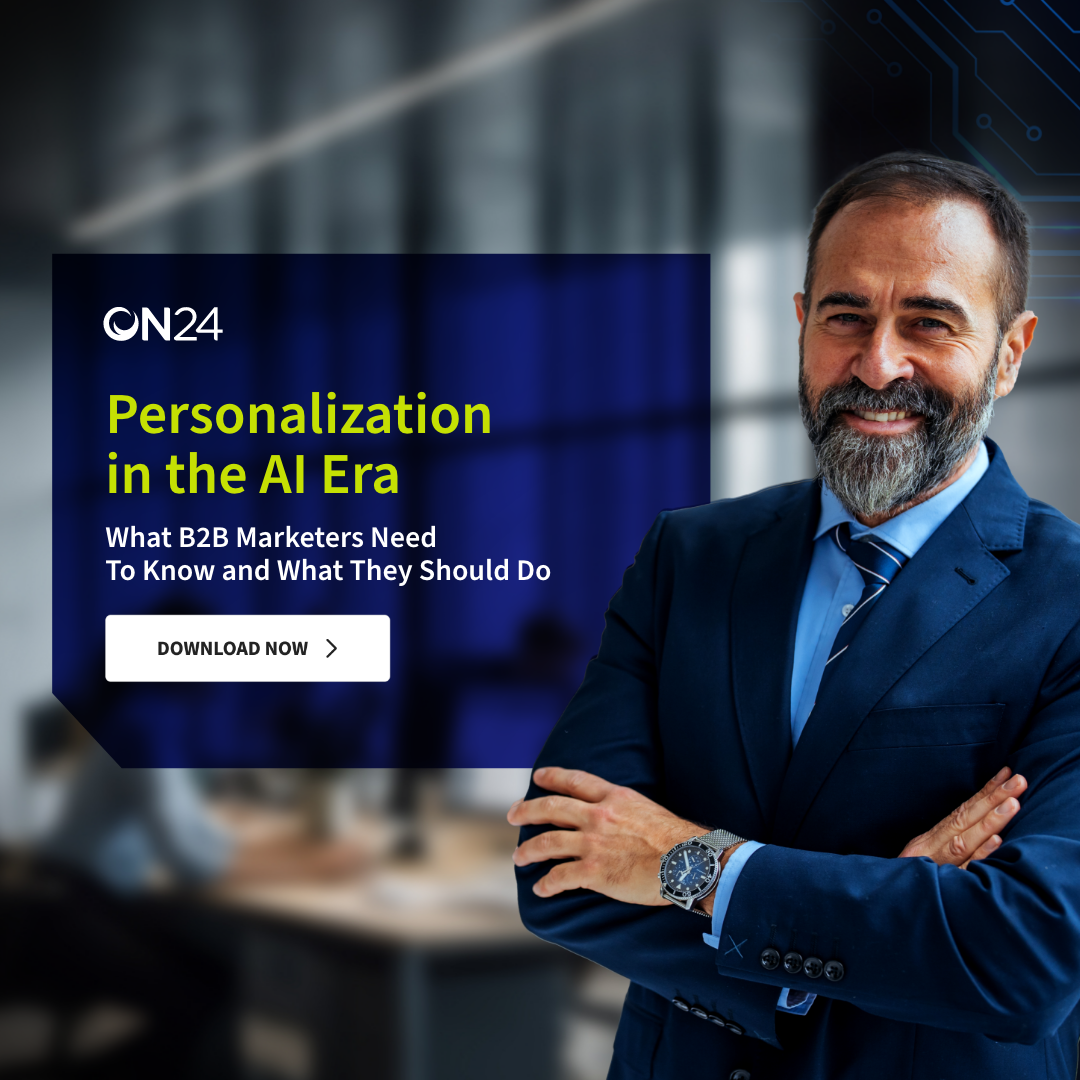B2B marketers know that to succeed in this hyper-competitive digital era, they need to make personalized digital experiences a reality. And they need to do it at scale.
But how? Generative AI and other AI-marketing tools offer enticing solutions — but they’re only as effective as the strategies they support. We’ve put together these seven tips to help you make personalization a reality in your marketing efforts. Read on to learn more.
1. Identify business goals and set specific KPIs for personalization

Focus on personalizing what matters most to your target recipient, avoiding low-quality efforts limited to little more than “Hi [first name],” instead, focus your efforts on what will result in tangible, scalable results.
-
- Start with the right overall goals: What are your current goals for your marketing programs? Are these connected to overall business goals (e.g., pipeline and revenue), or are they more arbitrary (e.g., total downloads or webinar attendees)?
- Focus on areas that personalization can support at scale: Identify what you aim to achieve with personalization (e.g., increase qualified leads by increasing engagement, increase meeting bookings by improving conversion rate). To ensure long-term growth and improvement, these activities should be automatically scaled up via digital channels rather than be limited to physical events.
- Identify the channels and touchpoints that are most promising: Any marketing tactic will only be successful if it reaches enough people and can drive sufficient outcomes. This means you should start by selecting areas where personalization will likely make a sizable difference—for example, in calls-to-action for on-demand demos or within content hubs that already attract a good number of visitors.
- Set smart KPIs to aim for with personalization: With the above identified, you can now take a less superficial approach to personalization and more aligned to results. Setting specific, measurable, actionable KPIs to achieve by a particular time will help focus your effort.
2. Understand your audience and key segments

Two elements are essential when targeting any audience or segment to personalize effectively at scale. The first is technical and based on precisely defined rules and data — so any contact in your marketing platforms can be assigned automatically for real-time personalization. The second is more human — so any personalized offer will likely align with a professional’s needs when they see it.
First, you must define the audiences and segments you want to target with personalized offers using specific criteria in your martech systems so that the right people see relevant offers. Second, to create and select offers that are likely to resonate, you need to understand the key drivers of these segments and tailor them accordingly.
-
- Define key audiences and segments using rules and data: Select specific data fields and apply rules in your martech systems to automatically assign contacts to named segments. Items include behavior, lead score or buying stage, firmographics and past interactions.
- Clarify what will appeal to these segments: Create detailed buyer personas to understand the unique needs, pain points and motivations of different segments. This can be used to create relevant offers and messaging.
3. Select, collect and integrate data that defines each segment

To personalize at scale and in real-time, your technology platforms must be configured appropriately and the data must be in the correct location.
-
- Centralize your first-party data into CRM and marketing automation platforms: Ensure your data is aggregated from various sources (such as your webinar platform, on-site chat, ABM solution) into a unified location. Start with first-party data.
- Enrich data for segments as needed: Where data is missing, look to third-party sources or try to infer it as required. AI solutions can be effective here, for example, by automatically tagging contacts with interest fields based on past behavior and content consumption.
- Create segments using your criteria: Having defined your segments earlier, set up segments within your technology platforms. Use dynamic segmentation to automatically assign or remove contacts to each segment so personalization can happen in real time.
- Integrate platforms to activate offers and track performance: To deliver personalized offers where needed, ensure the data to identify your segments is available. For example, ON24 customers can target segments using 6sense scores or Marketo program IDs.
4. Implement analytics for insights and measurement

Before launching any offers to your target segments, your reporting must be set up and ready. You should also test your setup to ensure performance data is collected correctly.
-
- Establish how and where you’ll track personalization performance: Be clear on where the data will be for your personalized offers. This may be in your CRM, marketing automation platform, or another part of your martech stack, such as your webinar platform, or may also be in a reporting tool (e.g., DOMO, Tableau, etc.).
- Test that data is being captured and reported correctly: Once you’ve set up your tracking parameters, test them to ensure that data is being captured and reported correctly. You can do this by creating test segments, adding yourself (or a fake user) to the segment and then testing the offer to see if it is recorded. Use a different browser or anonymous window as needed.
- Configure reporting as needed: Once you know your tracking is working, you can configure your reporting to meet your needs. This can be as easy as adding a task to your calendar to check the data, or as detailed as scheduling custom reports to be sent by email.

5. Create and deploy personalized offers across channels and experiences

With all the preparation in place, now is the time to create customized content and push it to your audience.
-
- Create content and copy using AI: Creating promotional content is today’s most common AI use case for B2B marketers. Use text-based generative AI, such as SmartText, to craft promotional copy quickly to scale personalized and general marketing quickly. For images, tools such as Microsoft Copilot or Adobe Firefly can quickly create image assets as needed.
-
- Use templates to quickly build creative assets and offers: When possible, use pre-designed templates to create visually appealing personalized offers in the right size and format, from calls to action to content hub images. Customize templates with your branding, images and text to create unique and professional-looking assets.
-
- Use data to dynamically personalize content: Any data field can personalize offers and pages. At a basic level, this might include adding an account logo for the contact’s company on a nurture page. A more advanced model might adapt language for a post-webinar content hub, depending on whether they attended or not.
-
- Set up triggered nurtures: Use marketing automation tools to set up automated campaigns that nurture leads and drive conversions. For example, contacts with a low lead score can be sent more top-of-funnel content, while those with a high lead score are sent bottom-of-funnel content such as case studies or ROI calculators.
-
- Use AI-powered recommendations where possible: To save even more time, AI tools can automatically identify and recommend content based on a contact’s attributes and how well different content performs. This can be particularly useful for one-to-many personalization, which requires no manual intervention or setup.
6. Review, test and optimize based on results

After some time has passed, the results gathered provide an excellent opportunity to improve your personalization and gain additional results.
-
- Assess the performance of specific offers and channels: Where results were good, expand the same method to new segments, channels, or campaigns. Similarly, identify underperforming offers and channels, with a view to either optimizing them or shelving them for a different approach.
- Assess the performance of individual segments: Just as offers differ in performance, some segments may not convert at the expected rate for reasons separate from marketing. Others may convert at very high rates. Amend the segment definitions as needed and prioritize those showing the most potential.
- Revise offers and methods to gain additional results: Regularly review and update offers to ensure they are relevant and appealing, especially as repeated use may decrease effectiveness. Experiment with different copy, creative, channel and segment combinations to find the optimal combination or explore new channels and methods to reach potential customers, making decisions based on data.
7. Scale and expand for continuous improvement

Once an effective process is established, it should be scaled and expanded to maximize the potential for personalization.
-
- Adapt your approach based on changes in buyer behavior: As demonstrated over recent years, buyers change their preferences almost as fast as technology comes onto the market. Be ready to shift your strategy as their needs change.
- Continue to use technology and AI to automate and scale personalization efforts. Scaling personalization is only possible with technology. Keep innovating your processes to make the most of each technology solution you have.
- Expand personalization to new segments, products and offers. After optimizing your results from existing segments, roll out personalization to new ones so each gets the best possible experience.
- Continue to collect first-party data for the best results: As AI develops further, a foundation of first-party data will ensure that future personalization (especially those based on automatic, AI-powered optimization) is as effective as possible.
